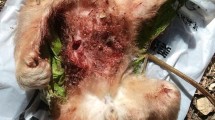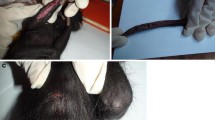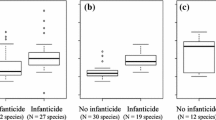Abstract
Infanticide might be described as a reproductive strategy employed by anthropoid primate males when they immigrate into new groups. But infanticide has rarely been observed in wild prosimian primates. For the Malagasy lemurs this may reflect one or more of the following: strict breeding seasons; relative monomorphism in canine tooth and body size; small group sizes; male–female dominance relations; and male–female dyads within groups. We addressed the following questions: Do prosimian males commit infanticide in circumstances similar to those in which anthropoids do? and Is there any reproductive advantage for a highly seasonal breeder to commit infanticide? To help answer these questions, we describe the death of a 24-hr-old infant male Propithecus diadema edwardsi from wounds received during a fight between his mother, her adult daughter, and a newly immigrant male. Interbirth intervals between surviving offspring are 2 years for Propithecus diadema edwardsi; therefore, a male could dramatically shorten the time between reproductive windows by killing an infant. Whether this tactic would be favored by sexual selection cannot be addressed until more information has been collected on the length of interbirth interval due to infanticide relative to that of infant death by other causes; how social factors such as stability of breeding relationships affect long-term male reproductive success; how effective female counterstrategies are to prevent infanticide and/or whether they choose to mate with males that commit infanticide; and how often males that kill infants subsequently sire infants, particularly in groups that contain a resident male.
Similar content being viewed by others
REFERENCES
Altmann, J. (1974). Observational study of behavior: Sampling methods. Behaviour 49: 227-265.
Bartlett, T. Q., Sussman, R. W. and Cheverud, J. M. (1993). Infant killing in primates: A review of observed cases with specific reference to the sexual selection hypothesis. Am. Anthropol. 95: 958-990.
Clarke, M. R. (1983). Infant-killing and infant disappearance following male takeovers in a group of free-ranging howling monkeys (Alouatta palliata) in Costa Rica. Am. J. Primatol. 5: 241-247.
Evans, C. S., and Goy, R. W. (1968). Social behaviour and reproductive cycles in captive ringtailed lemurs (Lemur catta). J. Zool. Soc. Lond. 9: 181-197.
Glander, K. E., Fedigan, L. M., Fedigan, L., and Chapman, C. (1991). Field methods for capture and measurement of three monkey species in Costa Rica. Folia Primatol. 57: 70-82.
Glander, K. E., Wright, P. C., Daniels, P. S., and Merelender, A. M. (1992). Morphometrics and testicle size of rainforest lemur species from southeastern Madagascar. J. Hum. Evol. 2: 1-17.
Hamilton, W. D. (1964). The genetical evolution of social behavior. J. Theor. Biol. 7: 1-51.
Hemingway, C. A. (1995). Feeding and Reproductive Strategies of the Milne-Edward's Sifaka, Propithecus diadema edwardsi, Ph.D., Duke University, Durham, NC.
Hiraiwa-Hasegawa, M., and Hasegawa, T. (1994). Infanticide in nonhuman primates: Selection and local resource competition. In Parmigiani, S., and vom Saal, F. S. (eds.), Infanticide and Parental Care, Harwood Academic, Switzerland, pp. 137-154.
Hood, L. C. (1994). Infanticide among ringtailed lemurs (Lemur catta) at Berenty, Reserve, Madagascar. Am. J. Primatol. 33: 65-69.
Hrdy, S. B., and Hausfater, G. (1984). Infanticide: Comparative and Evolutionary Perspectives, Aldin, New York.
Hrdy, S. B., Janson, C., and van Schaik, C. (1995). Infanticide: Let's not throw out the baby with the bath water. Evol. Anthropol. 3: 151-154.
Kappeler, P. M. (1990). Female dominance in Lemur catta, more than just female feeding priority? Folia Primatol. 55: 92-95.
Overdorff, D. J. (1997). Are Eulemur species pairbonded? Social organization and mating strategies in Eulemur fulvus rufus. Am. J. Phys. Anthropol. (in press).
Pereira, M. E., and Weiss, M. L. (1991). Female mate choice, male migration, and the threat of infanticide in ringtailed lemurs. Behav. Ecol. Sociobiol. 28: 141-152.
Pereira, M. E., Kaufman, R., Kappeler, P. M., and Overdorff, D. J. (1990). Female dominance does not characterize all the Lemuridae. Folia Primatol. 55: 96-103.
Sommer, V. (1994). Infanticide among the langurs of Jodhpur: testing the sexual selection hypothesis with a long-term record. In Parmigiani, S., and vom Saal, F. S. (eds.), Infanticide and Parental Care, Harwood Academic, Switzerland, pp. 155-198.
Strait, S. G., and Overdorff, D. J. (1995). Fracture toughness of plants eaten by Propithecus diadema edwardsi. Am. J. Phys. Anthropol. Suppl. 20: 206.
Strait, S. G., and Overdorff, D. J. (1996). Physical properties of fruits eaten by Malagasy primates. Am. J. Phys. Anthropol. Suppl. 21: 224.
Struhsaker, T. T., and Leland, L. (1987). Colobines: Infanticide by adult males. In Smuts, B. B., Cheney, D. L., Seyfarth, R. M., Wrangham, R. W., and Struhsaker, T. T. (eds.), Primate Societies, University of Chicago Press, Chicago, pp. 83-97.
Sussman, R. W., Cheverud, J. M., and Bartlett, T. Q. (1995). Infant killing as an evolutionary strategy: Reality or myth? Evol. Anthropol. 3: 149-151.
van Schaik, C. P., and Kappeler, P. M. (1993). Life history, activity period, and lemur social systems. In Kappeler, P. M., and Ganzhorn, J. U. (eds.), Lemur Social Systems and Their Ecological Basis, Plenum, New York, pp. 241-260.
Watts, D. P. (1989). Infanticide in mountain gorillas: New cases and a review of the evidence. Ethology 81: 1-18.
White, F. J., Balko, E. A., and Fox, E. A. (1993). Male transfer in captive ruffed lemurs, Varecia variegata variegata. In Kappeler, P. M., and Ganzhorn, J. U. (eds.), Lemur Social Systems and Their Ecological Basis, Plenum Press, New York, pp. 41-50.
Wright, P. C. (1992). Primate ecology, rainforest conservation and economic development: Building a national park in Madagascar. Evol. Anthropol. 1: 25-33.
Wright, P. C. (1995). Demography and life history of free-ranging Propithecus diadema edwardsi in Ranomafana National Park, Madagascar. Int. J. Primatol. 16: 835-854.
Author information
Authors and Affiliations
Rights and permissions
About this article
Cite this article
Erhart, E.M., Overdorff, D.J. Infanticide in Propithecus diadema edwardsi: An Evaluation of the Sexual Selection Hypothesis. International Journal of Primatology 19, 73–81 (1998). https://doi.org/10.1023/A:1020306910493
Issue Date:
DOI: https://doi.org/10.1023/A:1020306910493




